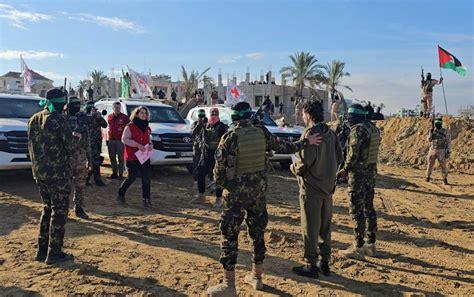
Hamas ‘regrouping under cover of hostage releases’
Hamas has been using hostage release operations to rebuild its forces and map territory within Gaza, Israeli sources have told The Telegraph.
The terror group is deploying more soldiers at each successive handover and conducting reconnaissance with drones that film the ceremonies.
US and Israeli officials have expressed outrage at the procession of captives through vast crowds, flanked by gunmen in masks and green bandanas before they are handed over to the Red Cross.
On Saturday, Hamas freed three hostages: Israeli Yarden Bibas, 35, American-Israeli Keith Siegel, 65, and French-Israeli Ofer Kalderon, 54, with drone footage of the handover released.
On Sunday, Benjamin Netanyahu, Israel’s prime minister, flew to Washington to meet Donald Trump, the US president, to discuss the next phase of the ceasefire deal, which could lead to Israel’s withdrawal from the Gaza Strip.
Mr Netanyahu is seeking the White House’s endorsement for his vision of the next phase of the war, Axios, a US news website, reported.
Major gaps remain in negotiations about a permanent ceasefire, including Hamas’s demand that it be allowed to stay in power in Gaza.
A total of 33 hostages are due to be released in the first phase of the current deal, in exchange for 2,000 Palestinians. A further 79 will only be returned to Israel if negotiations proceed to the second phase.
Israel has not placed any limits on the size of the Hamas force that attends each hostage release, said Ronen Solomon, an Israeli intelligence analyst.
He said: “We can see patterns of progress of the force of Hamas from ceremony to ceremony. By using these events, we can see that from a small force, each time they make it bigger, from a platoon to more like a brigade operation.
“We can see more soldiers each time, from 20 to 150 fighters with weapons, [and] more pick-up trucks like they used on Oct 7.”
A senior Israeli intelligence figure told The Telegraph: “Hamas has us on a tightrope because we don’t wish to give them a pretext to withdraw from the swap, but they are definitely taking advantage of these events to regroup.”
A senior military source also said that Israel had imposed “serious degradation” on Hamas’s military capability.
They claimed that recruitment efforts had not been as successful as estimated by the US State Department, which last month said that the terror group had signed up as many new fighters as had been killed during the past 16 months of fighting.
Israel estimates at least 17,000 Hamas fighters have been killed since the war began, but only a few hundred new, young and inexperienced recruits have been taken on, the military source added.
However, Mr Solomon said Israel could not afford to be complacent. “Each week we are starting to see how the forces are holding and handling their weapons and we see they are not inexperienced,” he said.
The quantity of equipment still held by the group is also coming to light after four rounds of hostage releases, with the ceremonies showing more arms, including machine guns, anti-tank missiles and drones.
Mr Solomon said: “Yes, Hamas is filming the hostage swap with the drones but they’re also collecting geographic information on the area and Israel can’t do anything about it while there is a ceremony.
“Each time they’re changing the location of the handover, so they’re mapping Gaza, Rafah, Khan Younis, Gaza Port, so they’re building the intelligence.”
Hiding out in its tunnel network, Hamas has had relatively limited information about the scale of the destruction across Gaza – and the impact it could have on future military operations.
The military source told The Telegraph that key tunnel routes across the Gaza Strip had been destroyed, including those linking the north to the south, between cities and to key intelligence centres.
Mr Solomon said: “These manoeuvres across Gaza, using different locations each time for the swap, enables Hamas to move [its] forces several kilometres, and the fighters are moving as units.
“Every truck has six to 10 fighters, a commander, communications like walkie-talkies, which are used to coordinate with the Red Cross, but it’s also the base to control the forces, a drill for the force to get experience again after months of guerrilla warfare.”
The ceremonies, widely publicised on Hamas’s social media channels, also aim to psychologically prepare the people of Gaza for the continued dominance of the terror group in the territory, Mr Solomon added.
Mr Netanyahu is due to hold talks with Mr Trump on Monday, becoming the first foreign leader to meet the president since he returned to the White House.
The Israeli prime minister said his meetings in the US would “deal with important, critical issues facing Israel and the region – victory over Hamas, achieving the release of all our hostages, and dealing with the Iranian terror axis in all its components, an axis that threatens the peace of Israel, the Middle East, and the entire world.”
Source » telegraph.co.uk





